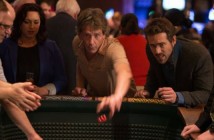Editor’s Notes: The following review is part of our coverage of the 2015 Vancouver International Film Festival. For more information on the festival visit viff.org and follow VIFF on Twitter at @viffest.
Joachim Trier’s English feature Louder than Bombs is an exceptionally well directed and well written story of a family still grieving the loss of their matriarch when a retrospective of her photojournalism of the Middle East occurs three years after her death. Gene (Gabriel Byrne), the patriarch, and his sons Jonah (Jesse Eisenberg) and Conrad (Devin Druid) have difficulties connecting with each other, since they stopped communicated after her death. Most affected and distraught, Conrad, who was only 12 when the incident occurred, negates the world, avoids his father, and surrenders to a closed-off life of introversion, video-games, loneliness, and anger. Jonah, a newlywed and sudden first time father, faces his own family issues, unable to connect with his new family for a lack of closure with his first. He leaves his wife and baby to close the curtains on his mother’s impact, one which is made especially more fraught due to the nature of her death and Conrad’s unawareness thereof.
The film is told in an episodic form, resembling the structure of art cinema, yet remains highly accessible, hitting the right notes on a number of levels: artful cinematography, emotional resonance, and entertainment value. It begins with a stunning shot of a baby’s finger wrapped by a woman’s hand in bright white light—a shot resembling those found in Terrence Malick’s acclaimed Tree of Life. This shot sets a precedent for what we are about to see: a bold yet subtle and highly professional film.
Louder Than Bombs is exceptionally cinematic. Trier utilizes a number of different techniques in a controlled and meticulous manner to express exactly what is needed to move the story forward. To complement his directorial front is a script which involves flashbacks and condensed storytelling to reveal what is needed at its necessary moment. As a result, the film moves forward fluidly, with superb pacing and a sense of building towards a highly deserved climax and catharsis. The use of voice-over with montage is most noteworthy, as scenes involving this coupled technique are excellent, particularly when Jonah reads Conrad’s story and the happenings are shown in conjunction.
Slow motion, soft zooms and point of view photography come into play at all the right moments, as the film is confidently and rationally directed by Trier. The omniscient voice-overs provide nostalgia for the present moment, while an ambient soundtrack delicately produces a grand emotional presence. In addition, archival footage from the depicted photographer provide plenty of eye-candy, as do the number of gorgeous shots, such as that of a woman floating in water as well as a time-lapse montage of decaying vegetables and flesh. Overall, the film is genuine and refined with an understated narrative arc which authentically portrays the characters in question.
The film is genuine and refined with an understated narrative arc which authentically portrays the characters in question.





Pingback: http://www.dvgtech.pro/()